Since no one has posted a complete solution, here's an approach. Using the observation that the desired text is in white and that words are structured in a horizontal alignment, we can use color segmentation to extract and OCR the letters.
Perform color segmentation. We load the image, convert to HSV format, define lower/upper ranges and perform color segmentation using cv2.inRange() to obtain a binary mask
Dilate to connect text characters. We create a horizontal shaped kernel using cv2.getStructuringElement() then dilate using cv2.dilate() to combine individual letters into a single contour
Remove non-text contours. We find contours with cv2.findContours() and filter using aspect ratio to remove non-text characters. Since the text is in a horizontal orientation, if the contour is determined to be less than a predefined aspect ratio threshold then we remove the non-text contour by filling in the contour with cv2.drawContours()
Perform OCR. We bitwise-and the dilated image with the initial mask to isolate only text characters and invert the image so that the text is in black with the background in white. Finally, we throw the image into Pytesseract OCR
Here's a visualization of each step:
Input image

Mask generated from color segmentation

# Load image, convert to HSV format, define lower/upper ranges, and perform
# color segmentation to create a binary mask
image = cv2.imread('1.jpg')
hsv = cv2.cvtColor(image, cv2.COLOR_BGR2HSV)
lower = np.array([0, 0, 218])
upper = np.array([157, 54, 255])
mask = cv2.inRange(hsv, lower, upper)
Dilated image to connect text-contours and removed non-text contours using aspect ratio filtering

# Create horizontal kernel and dilate to connect text characters
kernel = cv2.getStructuringElement(cv2.MORPH_RECT, (5,3))
dilate = cv2.dilate(mask, kernel, iterations=5)
# Find contours and filter using aspect ratio
# Remove non-text contours by filling in the contour
cnts = cv2.findContours(dilate, cv2.RETR_EXTERNAL, cv2.CHAIN_APPROX_SIMPLE)
cnts = cnts[0] if len(cnts) == 2 else cnts[1]
for c in cnts:
x,y,w,h = cv2.boundingRect(c)
ar = w / float(h)
if ar < 5:
cv2.drawContours(dilate, [c], -1, (0,0,0), -1)
Bitwise-and both masks and invert to get result ready for OCR

# Bitwise dilated image with mask, invert, then OCR
result = 255 - cv2.bitwise_and(dilate, mask)
data = pytesseract.image_to_string(result, lang='eng',config='--psm 6')
print(data)
Result from Pytesseract OCR using --psm 6 configuration setting to assume a uniform block of text. Look here for more configuration options
All women become
like their mothers.
That is their tragedy.
No man does.
That's his.
OSCAR WILDE
Full code
import cv2
import numpy as np
import pytesseract
pytesseract.pytesseract.tesseract_cmd = r"C:\Program Files\Tesseract-OCR\tesseract.exe"
# Load image, convert to HSV format, define lower/upper ranges, and perform
# color segmentation to create a binary mask
image = cv2.imread('1.jpg')
hsv = cv2.cvtColor(image, cv2.COLOR_BGR2HSV)
lower = np.array([0, 0, 218])
upper = np.array([157, 54, 255])
mask = cv2.inRange(hsv, lower, upper)
# Create horizontal kernel and dilate to connect text characters
kernel = cv2.getStructuringElement(cv2.MORPH_RECT, (5,3))
dilate = cv2.dilate(mask, kernel, iterations=5)
# Find contours and filter using aspect ratio
# Remove non-text contours by filling in the contour
cnts = cv2.findContours(dilate, cv2.RETR_EXTERNAL, cv2.CHAIN_APPROX_SIMPLE)
cnts = cnts[0] if len(cnts) == 2 else cnts[1]
for c in cnts:
x,y,w,h = cv2.boundingRect(c)
ar = w / float(h)
if ar < 5:
cv2.drawContours(dilate, [c], -1, (0,0,0), -1)
# Bitwise dilated image with mask, invert, then OCR
result = 255 - cv2.bitwise_and(dilate, mask)
data = pytesseract.image_to_string(result, lang='eng',config='--psm 6')
print(data)
cv2.imshow('mask', mask)
cv2.imshow('dilate', dilate)
cv2.imshow('result', result)
cv2.waitKey()
The HSV lower/upper color range was determined using this HSV color thresholder script
import cv2
import numpy as np
def nothing(x):
pass
# Load image
image = cv2.imread('1.jpg')
# Create a window
cv2.namedWindow('image')
# Create trackbars for color change
# Hue is from 0-179 for Opencv
cv2.createTrackbar('HMin', 'image', 0, 179, nothing)
cv2.createTrackbar('SMin', 'image', 0, 255, nothing)
cv2.createTrackbar('VMin', 'image', 0, 255, nothing)
cv2.createTrackbar('HMax', 'image', 0, 179, nothing)
cv2.createTrackbar('SMax', 'image', 0, 255, nothing)
cv2.createTrackbar('VMax', 'image', 0, 255, nothing)
# Set default value for Max HSV trackbars
cv2.setTrackbarPos('HMax', 'image', 179)
cv2.setTrackbarPos('SMax', 'image', 255)
cv2.setTrackbarPos('VMax', 'image', 255)
# Initialize HSV min/max values
hMin = sMin = vMin = hMax = sMax = vMax = 0
phMin = psMin = pvMin = phMax = psMax = pvMax = 0
while(1):
# Get current positions of all trackbars
hMin = cv2.getTrackbarPos('HMin', 'image')
sMin = cv2.getTrackbarPos('SMin', 'image')
vMin = cv2.getTrackbarPos('VMin', 'image')
hMax = cv2.getTrackbarPos('HMax', 'image')
sMax = cv2.getTrackbarPos('SMax', 'image')
vMax = cv2.getTrackbarPos('VMax', 'image')
# Set minimum and maximum HSV values to display
lower = np.array([hMin, sMin, vMin])
upper = np.array([hMax, sMax, vMax])
# Convert to HSV format and color threshold
hsv = cv2.cvtColor(image, cv2.COLOR_BGR2HSV)
mask = cv2.inRange(hsv, lower, upper)
result = cv2.bitwise_and(image, image, mask=mask)
# Print if there is a change in HSV value
if((phMin != hMin) | (psMin != sMin) | (pvMin != vMin) | (phMax != hMax) | (psMax != sMax) | (pvMax != vMax) ):
print("(hMin = %d , sMin = %d, vMin = %d), (hMax = %d , sMax = %d, vMax = %d)" % (hMin , sMin , vMin, hMax, sMax , vMax))
phMin = hMin
psMin = sMin
pvMin = vMin
phMax = hMax
psMax = sMax
pvMax = vMax
# Display result image
cv2.imshow('image', result)
if cv2.waitKey(10) & 0xFF == ord('q'):
break
cv2.destroyAllWindows()






